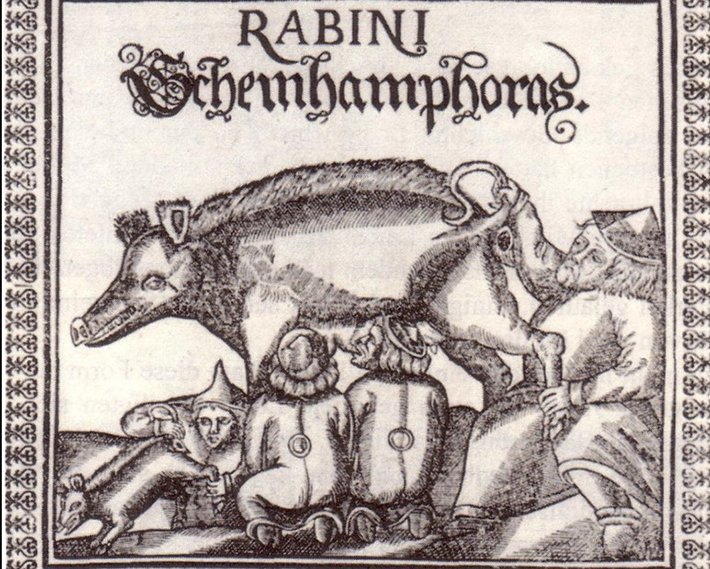The highest appeals court in Germany has ruled that a medieval sculpture can remain in front of a church, despite acknowledging that the antisemitic figure is offensive.

The Federal Court of Justice (Bundesgerichtshof) ruled June 14 that it was not unlawful for the church to display a 13th-century sandstone carving of “Judensau” or “Jew Sow,” depicting a caricature of a rabbi raising the tail of a pig and two Jewish children suckling on its teats. In doing so, the appeals court upheld rulings by lower courts that said the sculpture does not violate the law.
The case was brought by Michael Dietrich Düllmann, a 79-year-old retired nurse who converted to Judaism in the 1970s. He has long campaigned for the sculpture’s removal on the grounds that it is not only offensive but “dangerous” in light mounting antisemitism in Germany in recent years.
The sculpture, positioned some 13 feet from the ground, was installed around 1290 in the local church of Wittenberg, the city that was later the birthplace of the Protestant Reformation where Martin Luther lived and preached in the 16th century.
According to an article in Wikipedia, “in 1543, Martin Luther wrote the book Vom Schem Hamphoras und vom Geschlecht Christi (Of the Unknowable Name and the Generations of Christ). Schem Hamphoras is the Hebrew rabbinic name for the ineffable name of God. Luther's use of the term was in itself a taunt and insult to Jewish sensitivities.”
CNN reports that in 1570, the church in Wittenberg placed an inscription carrying the highly offensive phrase “Rabini Shem HaMphoras” above the sow.
According to Chabad.org, the website of the Chabad-Lubavitch movement, a branch of Hasidism, “there is probably no animal as disgusting to Jewish sensitivities as the pig. It’s not just because it may not be eaten: there are plenty of other animals that aren’t kosher either, but none of them arouse as much disgust as the pig. Colloquially, the pig is the ultimate symbol of loathing; when you say that someone ‘acted like a chazir [pig],’ it suggests that he or she did something unusually abominable.”
Despite this, and although the appeals court acknowledged that the phrase was based on this antisemitic text by Luther and that what the sculpture depicts is offensive, the court said that a bronze plaque the church installed in November 1988 and an information board under the relief memorializing the 6 million Jews who perished in the Holocaust mitigates the offense. The plaque also mentions Luther’s writing and other instances of anti-Jewish attitudes in Germany over the centuries.
The plaque and information board were part of Germany’s marking the 50th anniversary of Kristallnacht, the night in November 1938 when Nazis destroyed Jewish businesses, homes and synagogues across Germany, and rounded up some 30,000 Jewish men, sending them to concentration camps.
Josef Schuster, president of the Central Council of Jews in Germany, speaking about the court’s decision to CNN, said “neither the base plate nor the explanatory slanted display contain an unambiguous condemnation of the anti-Jewish work of art….Both the Wittenberg church community and the churches as a whole must find a clear and appropriate solution for dealing with sculptures that are hostile to Jews. Defamation of Jews by churches must once and for all be a thing of the past.”
Düllmann told CNN the appeal court’s ruling was “scandalous” and was an “underestimation of the real danger” of the sculpture. He plans to appeal to the German constitutional court.
Similar antisemitic propaganda is featured in more than 30 churches across Germany, Düllmann said.
“The Judensau isn’t only an insult, it’s so much more—it’s a call to murder the Jews,” he said. “Auschwitz came not from a vacuum. It was the result of centuries-long agitation against the Jews.”
_______________
From its beginnings, the Church of Scientology has recognized that freedom of religion is a fundamental human right. In a world where conflicts are often traceable to intolerance of others’ religious beliefs and practices, the Church has, for more than 50 years, made the preservation of religious liberty an overriding concern.
The Church publishes this blog to help create a better understanding of the freedom of religion and belief and provide news on religious freedom and issues affecting this freedom around the world.
The Founder of the Scientology religion is L. Ron Hubbard and Mr. David Miscavige is the religion’s ecclesiastical leader.
For more information visit the Scientology website or Scientology Network.


